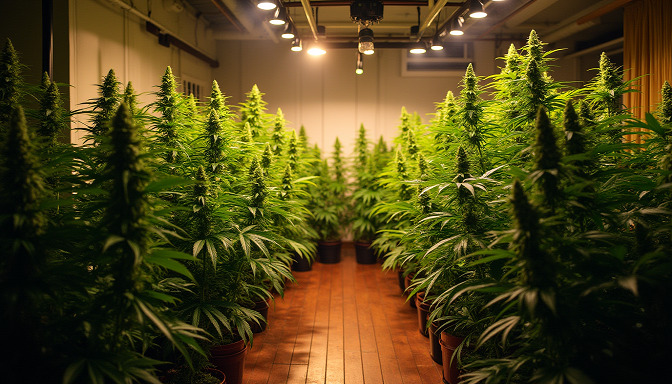
The Full Guide to Growing Weed at Home
Share
Editor’s Note (September 1, 2025):
Ready to get growing? We’ve refreshed this guide with a clearer image and sharpened tips to help you succeed—whether you’re just starting out or fine‑tuning your home grow setup.
If you’re getting started with seeds, check out How Long Marijuana Seeds Last for smart storage and germination tips to boost your success rate. And when you’re ready to move past seedlings, our guide Master the Cannabis Seedling Stage will help you handle those delicate first weeks with confidence.
Introduction
Welcome to Hurcann's ultimate guide to growing weed at home! Whether you're a seasoned horticulturist or a curious newbie, this comprehensive article will walk you through everything you need to know about cultivating your own cannabis plants.
From planting seeds to harvesting the fruits of your labor, we've got you covered! So grab your gardening gloves and get ready to embark on an exciting journey into the world of homegrown marijuana. But first things first, what is weed?

What is Weed?
You may have heard weed referred to as marijuana, cannabis, or pot. Cannabis is a plant that contains components called cannabinoids, which interact with our bodies' natural systems and produce various effects. Some of the main components are CBD, THC, or HHC.
The most well-known cannabinoid in weed is THC (tetrahydrocannabinol), which produces the "high" sensation that many users seek. However, there are also other cannabinoids like CBD (cannabidiol) that don't cause intoxication but provide potential therapeutic benefits.
Weed has been used for centuries across different cultures for both medicinal and recreational purposes. It's often consumed by smoking it in joints, pipes, or bongs. However, there are also alternative methods such as vaporizing or consuming edibles, oils, or tinctures.
It's important to note that while some countries and states have legalized the use of weed for medical and/or recreational purposes, it remains illegal in others. So, be aware of your local laws before growing or consuming weed.
With its diverse range of uses and effects on the body and mind, weed continues to be a subject of ongoing research and debate worldwide. Whether you're interested in exploring its therapeutic potential or simply want to experience its recreational effects responsibly, understanding what weed is can help guide your journey into this fascinating plant kingdom!

The 5 Benefits of Consuming and Growing Weed
Weed, also known as cannabis or marijuana, is consumed by many individuals for various reasons. Here are some of the main benefits you can obtain from consuming and growing weed.
- You can experience a sense of relaxation and euphoria.
- Alleviates symptoms of chronic pain.
- Helps combat diseases like cancer, parkinsons, and alzheimers.
- Reduces inflammation
- Enhances your creativity and helps you think outside the box.
Whatever the reason, it's important to always consume responsibly and within legal boundaries. So before growing weed in your home, which could be an inexpensive way of consuming it, check to see if your doctor recommends it, or if it’s even legal in the first place.

The Best Time to Plant Weed
When it comes to planting weed, timing is crucial. Choosing the best time to plant can greatly impact your harvest and the overall quality of your plants.
Understanding the optimal conditions for growth will help ensure a successful cultivation process. The ideal time to start planting weed depends on various factors such as:
- Daylight hours
- Temperature fluctuations
- Moisture levels in the soil
- Local climate patterns
- Strain selection
- Place of cultivation
- and personal preferences.
In general, most growers recommend starting in the early spring or late winter, when temperatures are still cool but consistent. However not all conditions of growing are the same, so here are a few considerations to take into account.
| Growing Conditions | What to do |
| Shorter growing season and harsh winters | Grow your seeds indoors which will allow you to control temperature and light conditions while giving your plants a head start before transplanting them outdoors once the weather warms up. |
| Longer growing seasons and milder climate | Planting directly outdoors may be feasible, however, it's important to keep an eye on local weather patterns and frost dates to avoid any potential damage from unexpected cold snaps. |
By carefully selecting the right timing for planting based on these factors specific to your location and strain choice, you increase the likelihood of achieving healthy growth and maximizing yields come harvest time.

The 5 Step Guide to Planting Weed
When it comes to planting weed, there are a few key steps you need to follow in order to ensure success. Here is the step by step guide.
- Choose the right location for your plants. Weed requires plenty of sunlight, so find a spot that gets at least six hours of direct sunlight each day.
- Prepare the soil by removing any weeds or debris and loosening it with a garden fork or tiller. Weed thrives in well-drained soil, so make sure yours is not too compacted.
- Once your soil is ready, it's time to sow the seeds. Plant them about half an inch deep and cover them lightly with soil.
- Water gently but thoroughly after planting to help settle the soil around the seeds. However, avoid overwatering, as this can lead to root rot.
- Keep an eye out for pests such as aphids or spider mites and take appropriate measures if necessary.
Remember that growing weed may be subject to legal restrictions depending on where you live. Always research local laws before embarking on this endeavor. With these steps in mind, you'll be well on your way to successfully planting weeds at home!

The 10 Step Guide to Growing Weed
Growing weed at home can be a rewarding and fulfilling experience. Whether you're a seasoned gardener or new to the world of cultivation, with the right knowledge and preparation, you can successfully grow your own cannabis plants.
- Choose the right strain for your desired outcome.
- Consider factors such as growth characteristics, flowering time, and THC levels.
- To start the germination process, place your seeds on a moist paper towel or directly into a small container filled with pre-soaked soil.
- Keep them in a warm environment with ample light until they sprout.
- Next comes transplanting your seedlings into larger pots or containers filled with nutrient-rich soil.
- Light is crucial for healthy plant growth. Cannabis plants require at least 18 hours of light during their vegetative stage and 12 hours of uninterrupted darkness during their flowering stage. Invest in high-quality grow lights if natural sunlight is not sufficient.
- Watering should be done carefully; too much can drown the roots, while too little can cause dehydration.
- Regularly monitor pH levels and adjust accordingly, as cannabis requires slightly acidic conditions for optimal nutrient absorption.
- Additionally, providing appropriate nutrients throughout each growth phase will help maximize plant health and yield potential.
- Once the buds are the appropriate size, you will be ready to cut the buds and clean them up.
Be patient! Growing weed takes time, but watching your plants flourish from seedlings into full-grown buds will make every effort worthwhile. And once you have your strains that are ready to consume, you will be ready to store it.

The 6 Tips to Store Your Weed
Proper storage is essential for preserving the quality and potency of your weed. Here are some tips on how to store it effectively:
- Invest in an airtight container made of glass or metal. Avoid plastic bags, as they can trap moisture and degrade your stash.
- Keep your weed in a cool, dry place with humidity levels between 59 and 63%.
- UV rays from sunlight can degrade THC, leading to reduced potency. Store your weed in a dark place or use tinted jars to protect it from light exposure.
- Store your cannabis at temperatures between 60 and 70°F (15 and 21°C). Extreme heat or cold can break down cannabinoids and terpenes.
- Grinding exposes more surface area, which increases the risk of oxidation and loss of potency. Only grind what you need before consumption.
- To maintain optimal humidity levels, consider using Boveda packs that release or absorb moisture as needed.
By following these guidelines, you'll ensure that your harvested weed stays fresh and potent for longer periods of time.
Conclusion
Growing weed at home can be a rewarding and fulfilling experience for both recreational and medicinal users. By understanding the basics of cannabis plant care and following the proper steps, you can cultivate your very own supply of high-quality weed.
Remember to research local laws and regulations before embarking on your home cultivation journey. It's important to stay informed about any legal restrictions or requirements in your area.
With patience, dedication, and attention to detail, you'll soon be enjoying the fruits (or rather, buds) of your labor. So go ahead, embrace your inner green thumb, and start growing marijuana at home today!
Disclaimer: Growing marijuana may be illegal in some jurisdictions. This article is purely for informational purposes only and does not encourage or endorse illegal activities. Always comply with local laws when it comes to cultivating cannabis plants.
